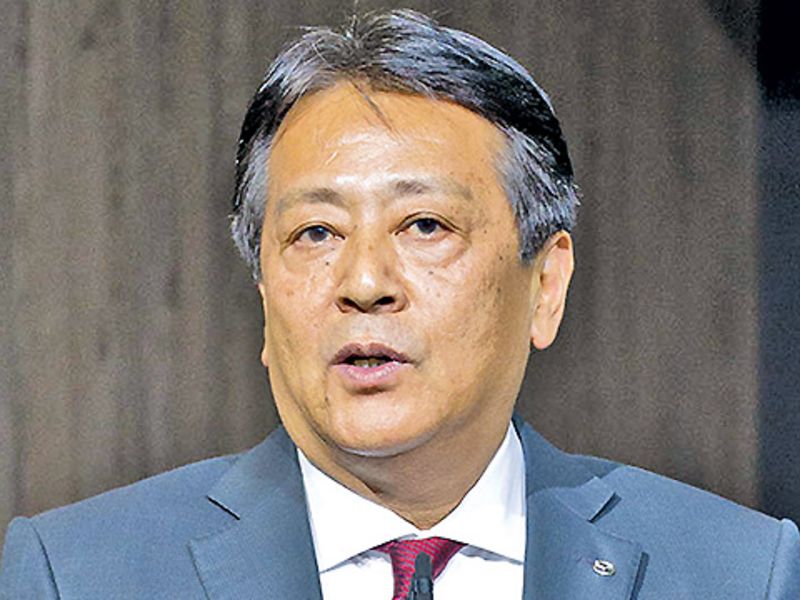
TOKYO — Mazda’s upcoming CX-50 crossover, designed specifically for American drivers, could be the brand’s new hero nameplate, delivering record U.S. sales as Mazda moves up market.
The entry, to be built at a new factory in Alabama, is envisioned boosting North American volume by 150,000, an impressive 34 percent surge over this year’s expected sales total.
Discussing the upcoming model while announcing Mazda Motor Corp.’s financial results last week, CEO Akira Marumoto said the CX-50 will play a crucial role in securing long-term profitability at the low-volume Japanese player. Mazda will release fresh details about the CX-50 in the United States on Monday, Nov. 15, Marumoto said.
But he teased some specs, saying the CX-50 was developed for U.S. market tastes with a wider tread and bigger cargo room. On the outside, it is expected to be around the size of Mazda’s CX-5 crossover, which is currently the automaker’s best-selling vehicle in the U.S.
“While continuing to sell the CX-5, we will introduce the CX-50 in North America in an attempt to bolster and expand our SUV lineup,” Marumoto said. Last year, in the heat of the pandemic, CX-5 sales declined only 5.3 percent to 146,420, in an overall market down 14 percent.
In North America, Mazda’s most important region, the company moved 403,000 vehicles in the fiscal year ended March 31, 2021. The U.S. accounted for 294,629 of them. Mazda said last week that it expects North American sales to climb to 438,000 in the current fiscal year ending March 31, 2022.
The CX-50, Marumoto predicted, will simply be gravy.
“On top of that, we plan to sell 150,000 units there,” he said of the CX-50 impact, predicting a sizeable increase in Mazda’s 2.4 percent regional market share.
“We have developed the car in line with requests from North American customers, so we have high expectations for the CX-50.”
Mazda’s peak U.S. selling year was in 1986, with 379,843 vehicles. Mazda’s total sales rose 0.2 percent to 279,076 vehicles in calendar year 2020, despite the overall market drop.
The CX-50 will start production in January at the new assembly plant in Huntsville, Ala., that Mazda is jointly operating with partner Toyota Motor Corp., which holds a 5.1 percent stake in Mazda.
The plant began producing Toyota’s Corolla Cross compact crossover in August. The operation has the capacity to make 300,000 vehicles a year, half for Toyota and half for Mazda.
Mazda is betting the CX-50 won’t cannibalize the long-selling CX-5, even though the two compact crossovers will be sold side by side, because the CX-50 is expected to have a wider stance than the CX-5 and offer a roomier interior and more rugged all-wheel-drive ability.
The CX-50 is part of a blitz of new crossovers coming from Mazda as it centers its lineup around bigger vehicles that have a more premium feel and fatter profit margins.
Last month, Mazda announced a fleet of new nameplates to be built on its upcoming large-vehicle platform, including the Mazda CX-60, CX-70, CX-80 and CX-90. All those new products will land between 2022 and 2023.
The CX-70 and CX-90 will focus on the U.S. The CX-50, which is not based on the new large-vehicle platform, will also be a North America-centric model.
Mazda’s tilt toward crossovers helped it bounce back to profitability in its fiscal second quarter ended Sept. 30, from operating and net losses the previous year.
In announcing results last week, Mazda also raised its full fiscal year net income target, even though it lowered its revenue and unit sales outlooks because of the semiconductor shortage.
Mazda still sees global sales increasing 2 percent, to 1.31 million vehicles, over the previous year.
The company’s long-term plan of achieving sustainable profitability revolves around reducing marketing cost per vehicle through lower incentives, increasing revenue per unit through more upscale offerings and higher prices, and better balancing of dealer stocks for lean inventories.
“We have spent so much time and energy on fundamentally changing the conventional U.S. way of spending a huge amount on incentives and fixed sales costs, as well as having a high inventory at dealerships,” Marumoto said.
“All these efforts have continued to a steady increase in our market share.”

